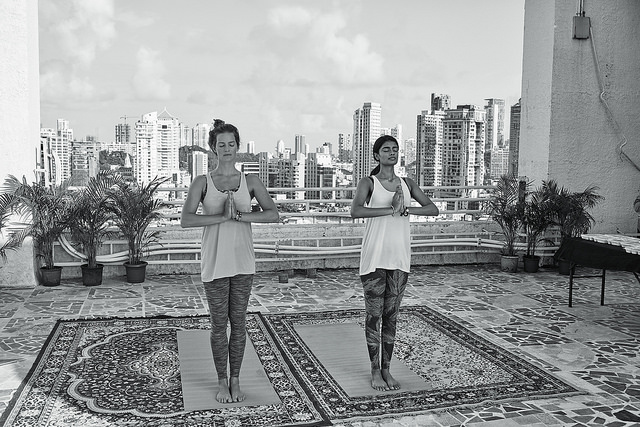You may be wondering whether it’s a better idea to take a yoga teacher training intensive at a foreign tropical retreat center or to do the gradual and more local approach.
While international teaching programs tend to draw exceptional talent and allow students to immerse themselves in a yogic culture, local trainings tend to be drawn out over many weekends, allowing for a slower ingestion of information and community building. Both routes are valid ways to become a yoga teacher.
Intensive Trainings
Some people just need to get away for awhile and enjoy fresh, beautiful scenery in a serene environment. Many international/intensive trainings last two to four weeks and total 200-300 hours of training. Some programs are 500 hours, but if you’re not yet a teacher you’ll probably start with your 200-hour certification.
Retreat centers are typically near beautiful and natural settings. When you’re not training, the vacation-like feel and the tranquil atmosphere will keep you calm and focused on your education.
Intensives also provide momentum. All you’re doing is practicing yoga and learning how to teach it. There are no major interruptions between classes, such as jobs which are often completely unrelated to yoga. If you need that kind of focus, then try an intensive.
Another great part about intensives is you can plan some travel time after the intensive. If the intensive is near Paris, for example, plan a two week trip across Europe. Since you already paid for the flight, you can extend your stay.
Cost is a major factor in people’s training choices. If you’re thinking about training abroad, expect to pay between $3,000 and $5,000 USD. Travel costs extra while food is often included in the package.
Local Trainings
If money is an issue and you want to do an intensive, you don’t necessarily have to travel far. You may find a program at a local studio or teacher training school. Maybe you’ll have to travel 100 miles to a retreat center or ashram, but at least you’ll save money on airfare.
Some people are a little more tied to their local realities due to children or other commitments. In this case, local night and weekend trainings are better. The training is typically similar to intensives. It’s just more gradual and your daily environment doesn’t change much. Instead, you’ll be dipping into trainings a few times a week for a few hours at a time.
Another reason to keep it local is it gives you more time to process what you’ve learned. You can do some extra studying in between classes to complement what you’re learning in the program.
Studying local also allows you to get to know your teachers in advance so you know whether you “vibe” with them—and even whether you might like to teach alongside them. It’s easier to know what you’re getting into so you don’t waste your time and money. However, if you’re doing an intensive, you may be able to find videos of your teacher giving classes. This will help you discover their teaching style and philosophy.
One of the greatest advantages of local teacher training is that many studios hire only those who take their trainings. If there’s a local studio you’d like to teach at, complete their training. You may want to do some detective work about how often they hire as well as turnover. Some studios have trained so many teachers that your chances of teaching there are slim.
If you want more friends, you might begin life-long relationships at a local training that can be nurtured well after you receive your teacher training certificate.
Local teacher training programs also help stimulate your yoga community and your local economy. Many studios rely on teacher training programs for their financial well-being. You’ll be helping yourself and your community at the same time.
Regardless of your choice, make sure the school is accredited with the right organizations. Yoga Alliance is a major accrediting institution, especially for those who want to teach in the USA. Independent Yoga Network is an alternative that separates yoga from the fitness industry. For those who want to focus on teaching in fitness centers, aim for the Register of Exercise Professionals. You’ll be more “fit” to teach in gyms and yoga schools. You can often get accredited with more than one of these boards. Ask the school about their options.
Whatever you decide, remember that your yoga teacher training choice isn’t the be-all-end-all of your yoga education. Even if you can’t afford an international training, you may be able to take an international workshop at a later date. Shop around, ask other teachers their experience, and listen to the little voice that tells you, “Yes, here!”
~
Author: Meera Watts
Image: INDISKA/Flickr
Editor: Travis May









Read 1 comment and reply